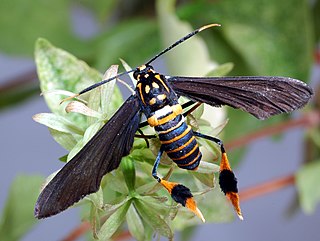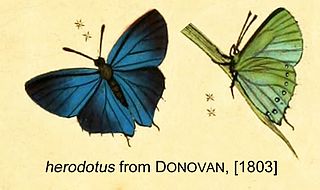
Boloria is a brush-footed butterfly (Nymphalidae) genus. Clossiana is usually included with it nowadays, though some authors still consider it distinct and it seems to warrant recognition as a subgenus at least.
Eunomia is a genus of moths in the subfamily Arctiinae erected by Jacob Hübner in 1818.
Mallodeta is a monotypic moth genus in the family Erebidae described by Arthur Gardiner Butler in 1876. Its single species, Mallodeta clavata, was described by Francis Walker in 1854. It is found in Brazil and Paraguay.

Phoenicoprocta is a genus of tiger moths in the family Erebidae. The genus was erected by Herbert Druce in 1898.

Hippotion velox, the dark striated hawkmoth, is a species of sphingid moth or the family Sphingidae. The species was described by Johan Christian Fabricius in 1793.

Horama panthalon, the Texas wasp moth, is a moth of the subfamily Arctiinae. The species was first described by Johan Christian Fabricius in 1793. It is found in South America, Central America, Mexico, the Antilles and southern United States.

Ponometia exigua is a moth of the family Noctuidae first described by Johan Christian Fabricius in 1793. It is found from Georgia, south to Florida and west to Texas. Outside of the United States it is found in Jamaica, Cuba, Hispaniola, the Virgin Islands and Central America and South America down to Brazil.

Hemiargus ceraunus, the Ceraunus blue, is a species of butterfly in the family Lycaenidae. The species was first described by Johan Christian Fabricius in 1793. It is found in the southwestern United States, southern Texas, Florida and the Florida Keys south through the West Indies, Mexico and Central America to South America. Strays may be found in North Carolina, Missouri, Kansas and Nevada. The habitat consists of open woodland, desert scrub, dunes, pastures, road edges and vacant lots.

Cyanophrys herodotus, the tropical green hairstreak or tropical greenstreak, is a butterfly of the family Lycaenidae. It was described by Johan Christian Fabricius in 1793. It is found in Mexico, Guatemala, Panama, Nicaragua, Colombia, Ecuador, Peru, Bolivia, Brazil, Paraguay and Argentina. Rare strays can be found as far north as southern Texas. The habitat consists of open disturbed areas in tropical and subtropical rainforests and cloudforests at altitudes ranging from 600 to about 2,000 meters.
Phoenicoprocta partheni is a moth of the subfamily Arctiinae. It was described by Johan Christian Fabricius in 1793. It is found on Haiti.
Psalis pennatula, the yellow hairy caterpillar, is a moth of the family Erebidae. The species was first described by Johan Christian Fabricius in 1793. It is found in India, Sri Lanka, Thailand, Australia and Java.





